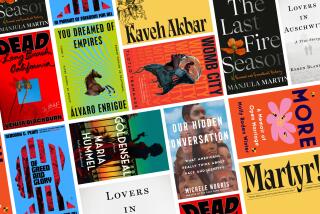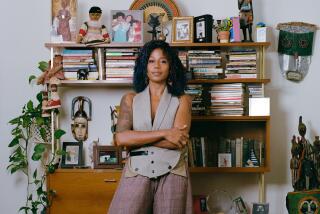The Kafka-esque struggle of an Afghan German girl is all too timely

Book Review
Good Girl
By Aria Aber
Hogarth: 368 pages, $29
If you buy books linked on our site, The Times may earn a commission from Bookshop.org, whose fees support independent bookstores.
Once in a blue moon a debut novel comes along, announcing a voice quite unlike any other, with a layered story and sentences that crackle and pop, begging to be read aloud. Aria Aber’s splendid “Good Girl” introduces just such a voice, chronicling a young Afghan German woman’s misadventures among Berlin’s night clubs and drug dens as she plunges into a volatile romance with an expatriate American writer. The book’s not without wobbles, but Aber, an award-winning poet, strikes gold here, much like Kaveh Akbar did in last year’s acclaimed “Martyr!”

Aber’s narrator, Nila, now on the cusp of 30, looks back a decade at her 19-year-old self, when she drifted into the orbit of Marlowe, a 36-year-old Californian who’d published a celebrated novel in his youth but hadn’t followed up, wallowing instead in liquor and ecstasy, hopping from bed to bed. Nila’s parents had been doctors in Kabul, but after immigrating to Berlin were forced to take menial jobs. They’re embedded within her father’s family and the blue-collar Afghan community, which the author evokes brilliantly: “My grandmother had the face of a fox, or that of a Soviet actress: thin, tattooed eyebrows over gray-green eyes, hair always bleached blond. She loved complaining and gave birth to seven children, including my father. She was the only one who wore chador, and God was a guideline more than a law.”
Nila feels the clash between a strict Shia upbringing and her lusty impulses. She’d earned a scholarship to an exclusive girls’ school, where she’d snuck out to party, and had suffered consecutive tragedies when her mother suddenly died and a girlfriend dropped her. Nila’s fear of abandonment drives “Good Girl”; her emotions pinwheel across the pages. Back in the city, she maintains a détente with her widower father and waitresses at a jazz club while applying to art schools in London; she yearns to be a photographer in the mode of Cindy Sherman and Diane Arbus. But she can’t escape the temptations around her.
If Nila is the occasional good girl, then Marlowe’s a bad boy, a Dionysus of Berlin’s demimonde, dispensing ecstasy and sex, gathering outsiders and anti-capitalists into his sphere. The hookups are fluid, and the ruminations on politics are plentiful. (There’s even a cat named Leon Trotsky.) Nila falls under the spell of this fast crowd “who took David Foster Wallace too seriously and deodorant not seriously enough.” Squeezed amid “bacterial” bathroom stalls, she immerses herself in a tide of speed and acid, later lying to her father when she stumbles home, her hair reeking of cigarettes. Marlowe, while in an open relationship with another woman, is attracted to Nila’s adventurous spirit and caustic intelligence. He gives her a Nikkormat camera and encourages her to pursue her passion. Their intimacy shades purple amid blasts of obsession and tenderness, yet Aber nimbly pulls off the Rimbaud act.
“Good Girl,” then, is a bildungsroman, gorgeously packed with Nila’s epiphanies on literature and philosophy, a tale of seductive risks and the burdens of diaspora. Kafka’s “Metamorphosis” hovers over “Good Girl” as its heroine undergoes a radical transformation. Marlowe considers himself more than just a lover; he’s also a mentor, gently steering her toward her own desires and how to express them through the art she makes (and indulging in a bit of mansplaining). She embraces and resents him, a 21st century repackaging of “Romeo and Juliet,” and like Shakespeare’s characters, the duo proceed to their doom. Their connection unravels.
Nila’s plan is to exit west; indeed, Aber’s prose has the lyrical lilt of Mohsin Hamid’s fiction. Her reckless behavior, including a trip to Italy, results in a kind of house arrest, straining her relationship with her surviving parent: “When my father left the apartment, he took that dangling chain of keys and locked the door from the outside like a janitor. … My tall, skinny father with silver streaks in his hair, the eyebrows that I brushed and trimmed for him.”
Like Nila, Aber was raised in Berlin, speaking Farsi and German. Ultimately, the divide within Nila reflects the growing chasm between east and west; she rightly perceives a spike in xenophobic nationalism across Europe and the United States. “Good Girl” views our current unrest through an inclusive prism: As the novel concludes, Nila visits an international cemetery, studded with headstones of Turks and Muslims, Germans and Jews. Literature, Aber suggests, may not only bridge warring peoples, but also bind our personal conflicts.
“On a molecular level, I believed, I comprehended what he wrote, even why he turned Gregor into a giant bug,” Nila observes of Kafka’s canonical work. “Who would understand the perils of a man trapped in his childhood room in unhuman form more than an Afghan girl trying to live?”
Hamilton Cain is a book critic in New York and the author of a memoir, “This Boy’s Faith: Notes From a Southern Baptist Upbringing.”
More to Read
A cure for the common opinion
Get thought-provoking perspectives with our weekly newsletter.
You may occasionally receive promotional content from the Los Angeles Times.










